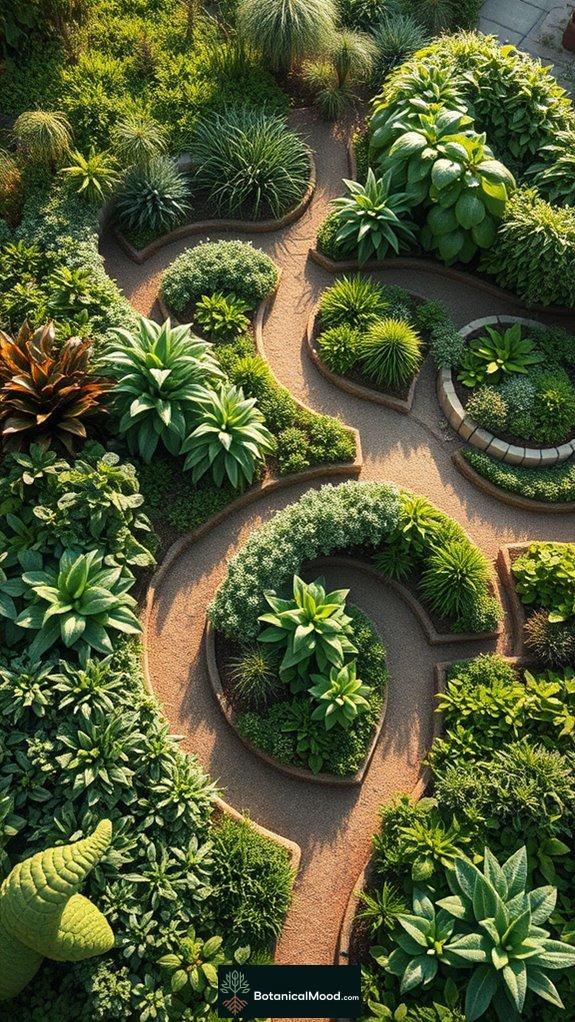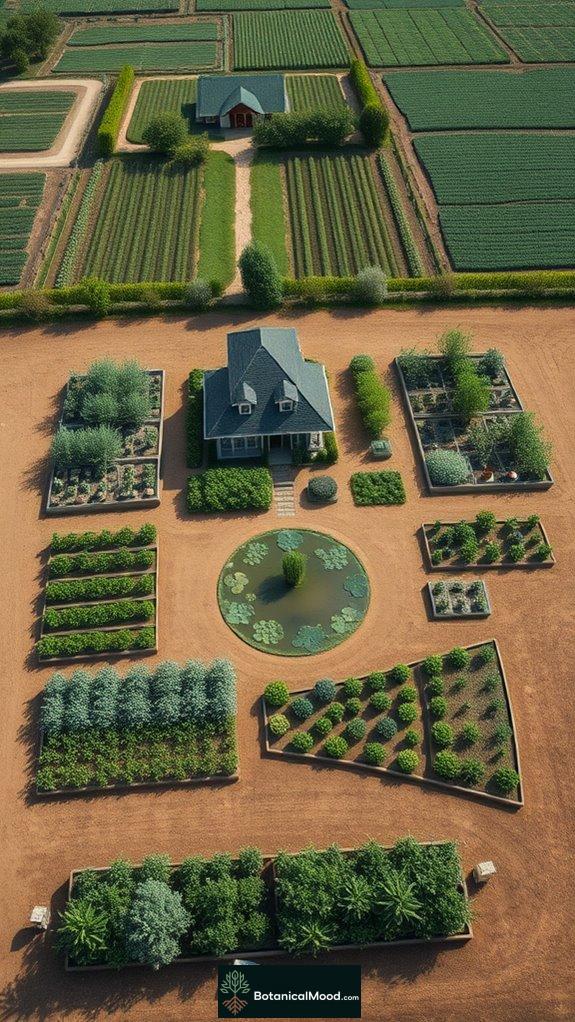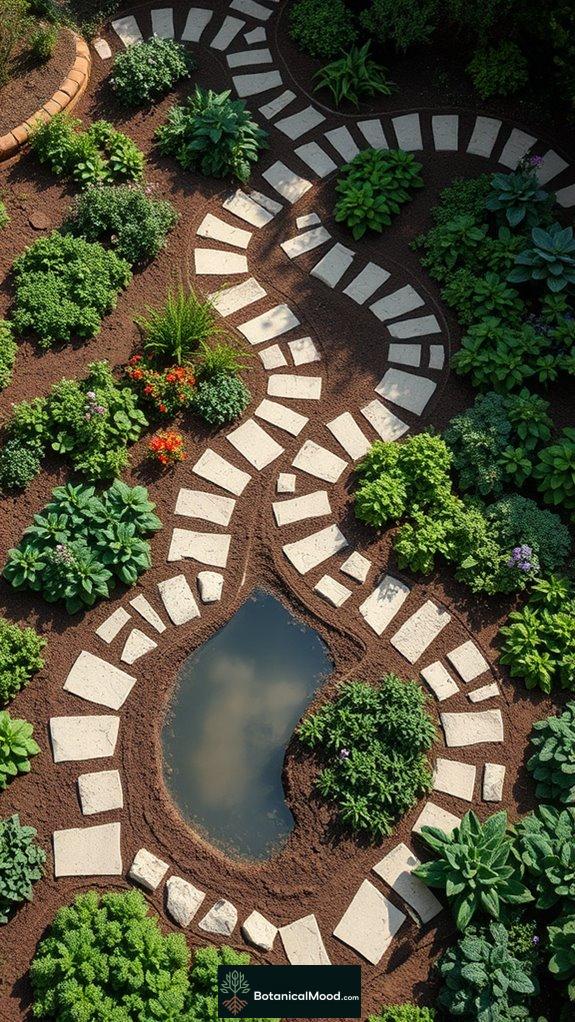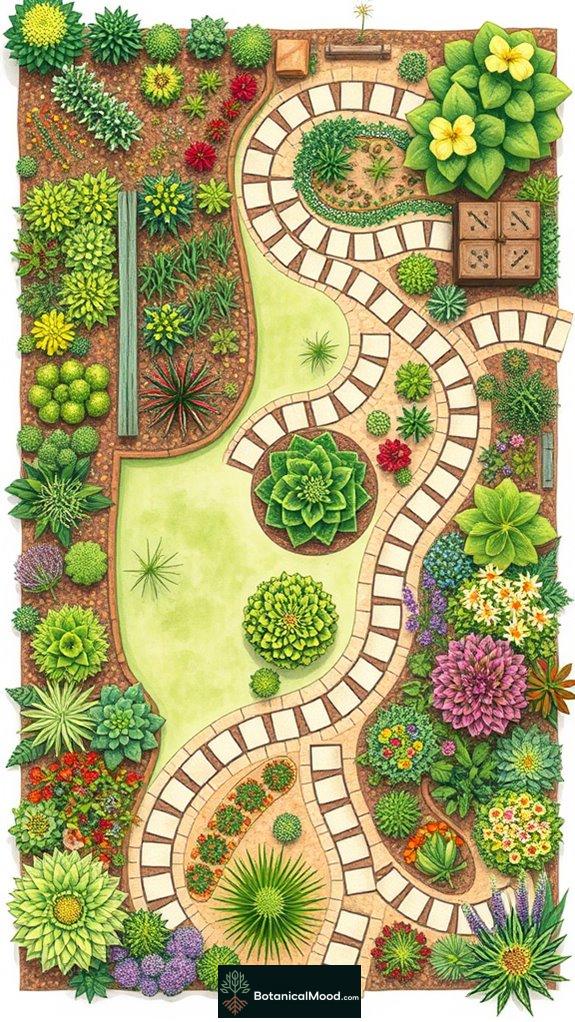Nature's canvas beautifully showcases permaculture garden sketches that draw inspiration from the natural world. These designs utilize complex, organic patterns, enhancing resilience and biodiversity while attracting beneficial insects. Integrated plantings create vibrant ecosystems by layering diverse plant species, while strategic zoning organizes the garden for efficiency. Multifunctional elements enrich the space, offering both aesthetic appeal and tangible benefits. With an emphasis on sustainable practices, these sketches reveal a harmonious relationship with nature, inviting further exploration into garden design.
Quick Takeaways
- Nature-inspired patterns enhance garden aesthetics while promoting ecological balance and resilience through integrated plantings.
- Zoning in permaculture gardens organizes space effectively, maximizing accessibility and functionality for various plant types and maintenance needs.
- Multifunctional elements like edible landscaping provide food, habitat, and ecological benefits, enriching both beauty and sustainability in garden designs.
- Innovative water management techniques, such as rainwater harvesting and drip irrigation, optimize resource use and enhance garden sustainability.
- Regular maintenance practices, including seasonal tasks and companion planting, ensure a thriving ecosystem that supports diverse plant species and health.
Nature-Inspired Patterns in Garden Design

When designing a garden, I often find myself captivated by the complex patterns that nature offers, as these patterns not only enhance beauty but also serve practical purposes. Incorporating nature aesthetics, I love to use organic motifs like spirals and waves, which mimic the flow of nature itself. These patterns create visual harmony while supporting ecological layering, allowing diverse plant life to thrive together. By embracing a wild spirit in urban gardens, I can encourage a partnership with nature that fosters resilience and biodiversity. Creating these patterns in the garden can also assist in improving soil health, as they promote water retention and reduce erosion. By mixing textures—coarse and fine foliage—my gardens become vibrant ecosystems, reducing the need for fertilizers. I created Botanical Mood to inspire others to appreciate these stunning designs and embrace sustainable gardening practices that reflect nature's artistry.
Integrated Plantings for Resilient Ecosystems

Integrated plantings not only elevate the aesthetic appeal of a garden but also foster resilient ecosystems that thrive with minimal intervention. By integrating diverse plant species, we emulate nature's complex web, creating balanced, integrated ecosystems that support each other. These resilient designs minimize pest pressures and enhance soil health, allowing gardens to flourish while promoting biodiversity. For example, incorporating native plants can significantly attract pollinators, boosting the overall health of the garden. I've found that such systems, often featuring livestock, create synergy, enriching soil fertility and reducing waste. As I explore this harmonious approach on Botanical Mood, I'm constantly inspired by how innovative integrated plantings can transform our gardens into sustainable, beautiful environments that endure. This method aligns with permaculture principles, emphasizing the importance of observing natural patterns to enhance garden resilience.
Zoning: Organizing Your Garden for Efficiency

Creating a productive garden goes beyond just choosing the right plants; it involves organizing them efficiently to maximize their potential. Understanding zone definitions and zone interactions is key to achieving this.
Here's how I approach zoning:
- Zone zero: My home, the central hub of operations.
- Zone one: Daily attention areas, like herb gardens and vegetable plots. Zoning helps in time management within the garden system and ensures efficiency in maintenance and resource use. This zone typically includes intensive planting to provide a diverse range of fresh produce.
- Zone two: Orchards and ponds with regular maintenance.
- Zone three: Larger agricultural areas, requiring less frequent visits.
Multifunctional Elements for a Sustainable Space

While I've always appreciated the beauty of a well-designed garden, I've come to realize that true sustainability lies in the multifunctional elements we choose to include.
Incorporating plants and animals that offer multifunctional benefits creates a vibrant ecological harmony.
For instance, apple trees not only provide delicious fruit but also attract beneficial insects and serve as natural windbreaks. Additionally, edible landscaping can enhance the aesthetic appeal of your garden while providing food and habitat for wildlife.
Water Management Techniques for Conservation

Water management techniques are essential for conserving our most precious resource in the garden.
Water management is crucial for preserving our invaluable resource in the garden.
I've found that implementing innovative strategies can greatly enhance sustainability.
- Rainwater harvesting techniques capture natural precipitation for later use.
- Greywater recycling methods allow me to reuse water from sinks and showers for irrigation.
- Swales and berms slow down water flow, improving groundwater recharge.
- Drip irrigation delivers water directly to plant roots, minimizing waste.
In addition, incorporating permaculture principles encourages a holistic approach to water conservation.
These practices not only nurture the garden but also inspire others to rethink their water usage, aligning perfectly with the vision I've for Botanical Mood.
Visualizing Layers: Creating a Productive Canopy

Visualizing a productive canopy in a permaculture garden not only enhances its aesthetic appeal but also creates a thriving ecosystem beneath.
By integrating diverse canopy layers, such as towering timber trees and fruiting sub-canopy species, I cultivate a vibrant environment that fosters nutrient cycling. These layers interact dynamically, enriching soil health and promoting biodiversity.
As the larger trees create a protective microclimate, the understory benefits from filtered sunlight, encouraging growth and resilience. Embracing native wisdom in this layered approach further enhances the garden's sustainability and resilience against environmental changes.
My passion for this layered approach inspired Botanical Mood, where I share perspectives on designing gardens that are both beautiful and ecologically harmonious, maximizing the potential of every inch.
The Role of Polycultures in Permaculture Design

Creating a rich tapestry of life, polycultures play an essential role in the success of permaculture design. I've seen firsthand how these diverse plant groups enhance garden resilience while mimicking natural ecosystems. The polyculture benefits are remarkable, including:
- Improved soil health and nutrient cycling
- Increased biodiversity and pest resistance
- Efficient use of space and resources
- Enhanced yields with reduced need for chemicals
Companion planting, where plants support each other's growth, is key in creating these thriving systems. Additionally, incorporating companion planting techniques can maximize the benefits of plant relationships, further boosting the overall health of your herb garden.
Sketching Out Your Vision: Tips for Effective Planning

How can you transform your garden dreams into a tangible reality?
Start with design visualization by sketching your ideas. I've found that taking time to observe the land reveals its unique potential and limitations, guiding my planning strategies.
Incorporating holistic thinking allows me to blend all ecosystem elements into my designs. Contour planting and bed orientation can enhance water management and sunlight exposure.
Keep in mind to create access pathways for easy maintenance. As I refine my plans, I embrace sustainability, ensuring long-term resource use and minimal waste. This approach reflects the ethos behind creating Botanical Mood, where innovation meets nature's beauty. Additionally, employing design principles can greatly influence the effectiveness of your garden layout.
Garden Zones and Patterns

Understanding the layout of your garden through zones and patterns can greatly improve both efficiency and harmony within your space.
By embracing zone interaction and pattern utilization, I've transformed my garden into a thriving ecosystem.
Here are some observations:
- Zone 1: Keep your kitchen garden close for easy access.
- Zone 2: Plant fruit trees for less frequent harvesting.
- Zone 3: Incorporate pastures to support livestock.
- Patterning: Use natural shapes to enhance aesthetics and function.
Additionally, implementing eco-friendly layouts can optimize resource use and maintain ecological balance in your garden.
Sketching Sustainable Garden Layouts

As I explore the art of sketching sustainable garden layouts, I find that envisioning a garden is more than just a creative exercise; it's a pathway to cultivating an ecosystem that flourishes with life.
Incorporating diverse plant species and using eco-friendly materials, like reclaimed timber and permeable pathways, enhances both garden aesthetics and functionality. I prioritize water conservation through features like rain gardens, which naturally absorb runoff. By creating microhabitats and mixing boundary hedges, I invite wildlife into the space.
This approach not only enriches the environment but also inspires my work at Botanical Mood, where I encourage others to embrace innovative, sustainable gardening practices. Furthermore, implementing rainwater harvesting systems allows for efficient water management and supports the overall health of the garden.
Hand-Drawn Garden Design Techniques

Hand-drawn garden design techniques serve as a bridge between imagination and reality, allowing me to transform ideas into tangible layouts.
The beauty of hand drawn aesthetics lies in their organic shapes, which reflect the natural world.
Here's how I approach my designs:
- Site Measurements: Accurate base maps guarantee a solid foundation.
- Conceptualization: Sketching on trace paper lets me explore ideas freely.
- Detailing: I finalize designs on vellum, focusing on complex details.
- Rendering: Adding color with markers brings my visions to life.
Incorporating companion planting strategies can further enhance the productivity of my garden designs.
These techniques inspire my work at Botanical Mood, where I celebrate the art and science of gardening.
Garden Maintenance Responsibilities

Maintaining a garden is essential for fostering a thriving ecosystem, as regular upkeep guarantees plants receive the care they need to flourish.
Garden care isn't just about aesthetics; it's a commitment to understanding seasonal tasks and establishing a maintenance schedule. Observing plant health, detecting pests early, and managing soil nutrients create a stable environment for growth.
Seasonal practices like mulching in summer or composting in autumn enrich the soil, while water management techniques, such as rainwater harvesting, guarantee sustainability. Incorporating drought-resistant landscaping with native plants can further enhance your garden's resilience and reduce water usage.
References
- https://content.ces.ncsu.edu/extension-gardener-handbook/appendix-g-permaculture-design
- https://thedruidsgarden.com/2016/09/25/permaculture-design-by-nature-and-the-magic-of-intentionality/
- https://green-connect.com.au/heres-your-guide-to-the-12-principles-of-permaculture/
- https://transformativeadventures.org/2017/11/22/what-is-permaculture-a-primer-in-pictures-and-patterns-part-2/
- https://www.tenthacrefarm.com/what-is-permaculture/
- https://www.thenewperennialist.com/wild-ish-at-heart-naturalistic-planting-design/
- https://stylebyemilyhenderson.com/blog/what-is-a-native-garden-how-do-you-create-a-garden-color-palette
- https://livingpermaculturepnw.com/how-to-design-a-permaculture-garden-in-your-backyard/
- https://www.amandapatton.co.uk/blogs/modern-natural-gardens/
- https://www.ecofriendlyhomestead.com/sustainable-garden/learn/integrate-permaculture-design-with-regenerative-gardening-a-complete-guide

Leave a Reply